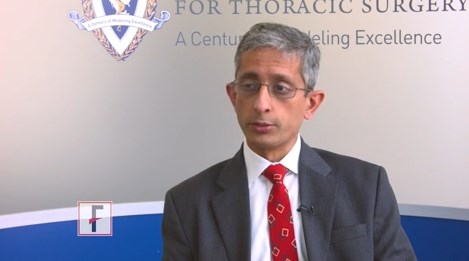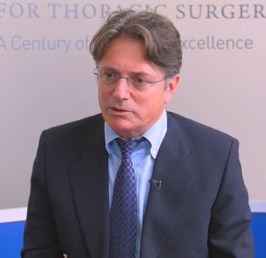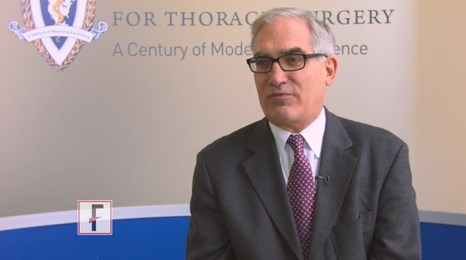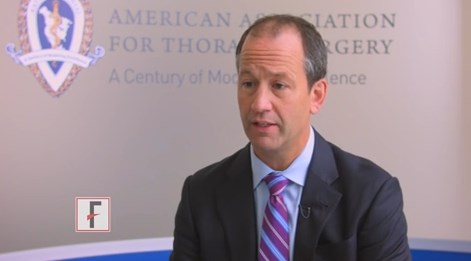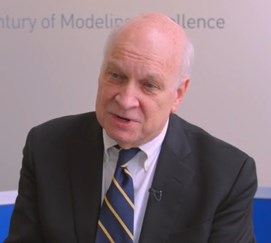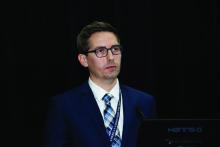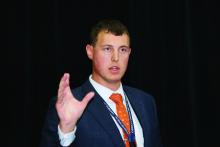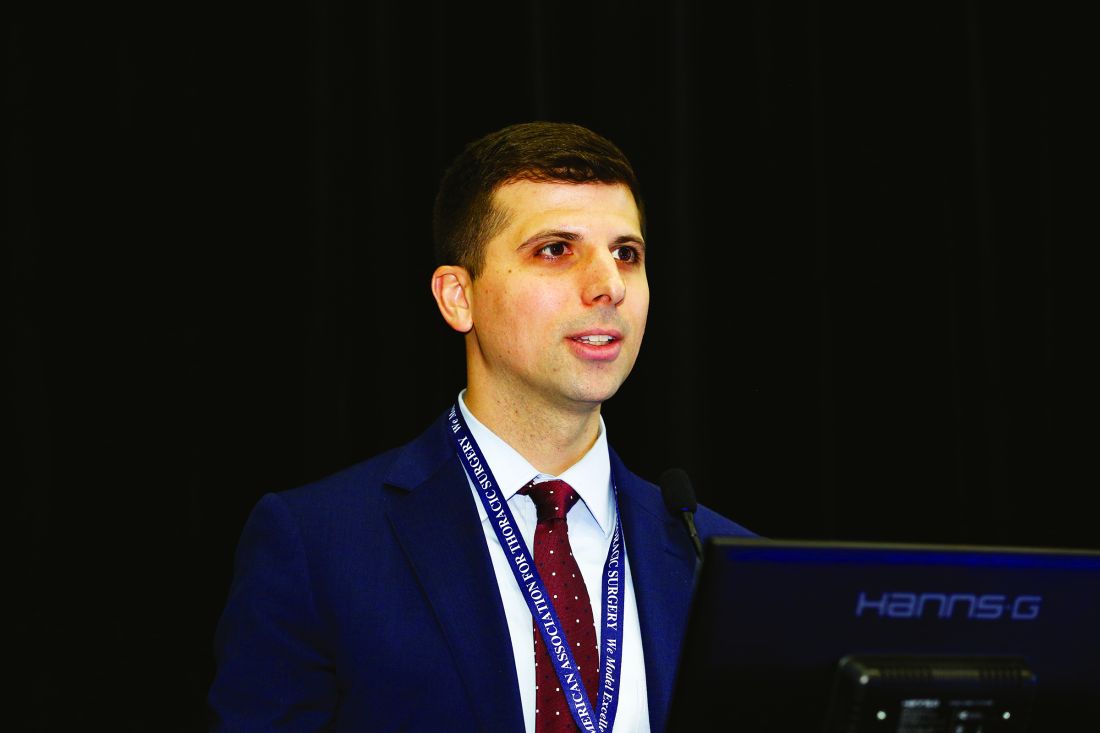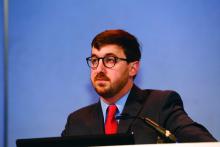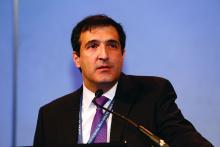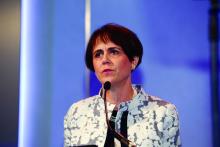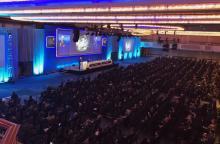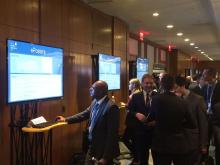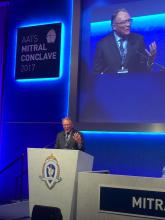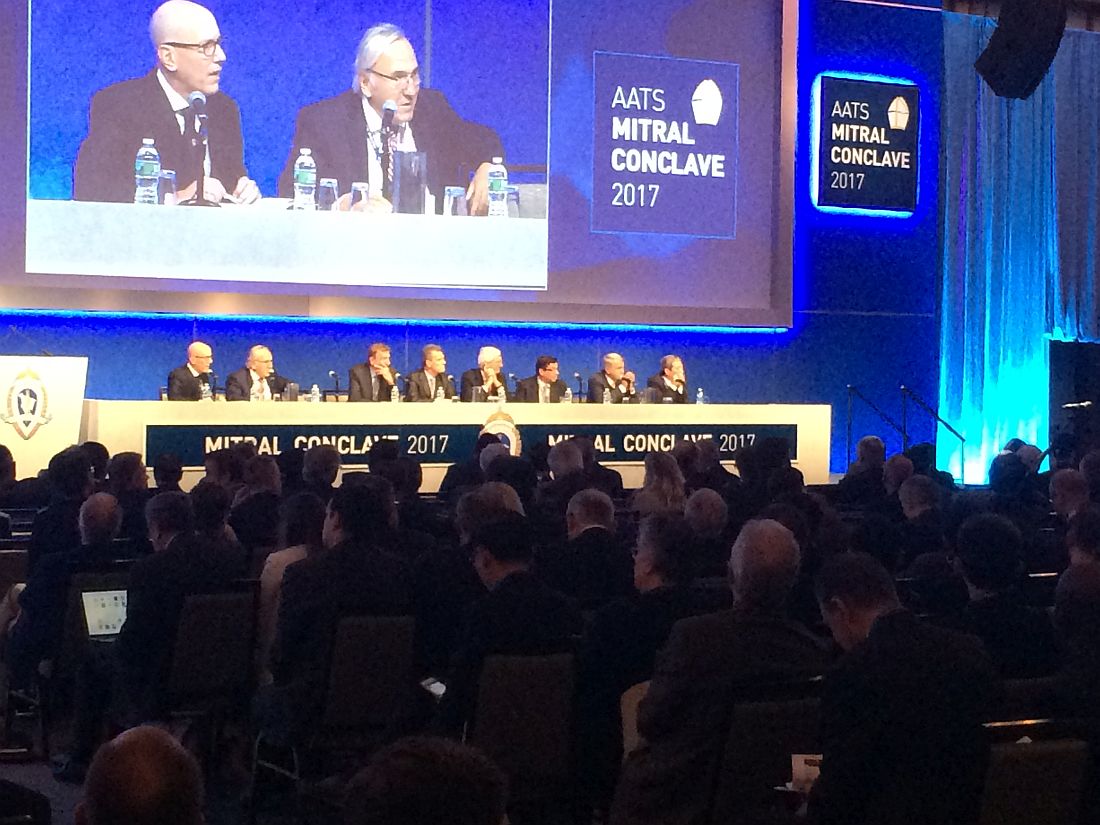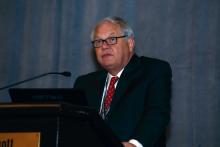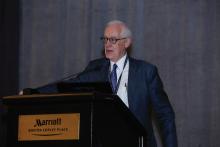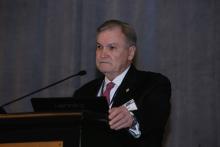User login
VIDEO: Wedge resection offers higher survival for NSCLC
BOSTON – High quality wedge resection results in higher survival for patients with early stage non–small cell lung cancer when compared with stereotactic body radiation therapy, according to new research.
The analysis, reported at the annual meeting of the American Association for Thoracic Surgery, evaluated the treatment of 7,337 patients in the National Cancer Database with clinical T1-T2, N0, M0 non–small cell lung cancer who were treated with either wedge resection or stereotactic body radiation therapy from 2005 to 2012.
In this video, Varun Puri, MD, of Washington University, St. Louis, discusses the study and the significance of the findings.
The video associated with this article is no longer available on this site. Please view all of our videos on the MDedge YouTube channel
agallegos@frontlinemedcom.com
On Twitter @legal_med
BOSTON – High quality wedge resection results in higher survival for patients with early stage non–small cell lung cancer when compared with stereotactic body radiation therapy, according to new research.
The analysis, reported at the annual meeting of the American Association for Thoracic Surgery, evaluated the treatment of 7,337 patients in the National Cancer Database with clinical T1-T2, N0, M0 non–small cell lung cancer who were treated with either wedge resection or stereotactic body radiation therapy from 2005 to 2012.
In this video, Varun Puri, MD, of Washington University, St. Louis, discusses the study and the significance of the findings.
The video associated with this article is no longer available on this site. Please view all of our videos on the MDedge YouTube channel
agallegos@frontlinemedcom.com
On Twitter @legal_med
BOSTON – High quality wedge resection results in higher survival for patients with early stage non–small cell lung cancer when compared with stereotactic body radiation therapy, according to new research.
The analysis, reported at the annual meeting of the American Association for Thoracic Surgery, evaluated the treatment of 7,337 patients in the National Cancer Database with clinical T1-T2, N0, M0 non–small cell lung cancer who were treated with either wedge resection or stereotactic body radiation therapy from 2005 to 2012.
In this video, Varun Puri, MD, of Washington University, St. Louis, discusses the study and the significance of the findings.
The video associated with this article is no longer available on this site. Please view all of our videos on the MDedge YouTube channel
agallegos@frontlinemedcom.com
On Twitter @legal_med
AT THE AATS ANNUAL MEETING
VIDEO: Lack of heart teams impact prevalence of PCI
BOSTON – Data show a marked bias in referral patterns for coronary revascularization in stand-alone interventional cardiology units lacking a heart team.
More patients underwent percutaneous coronary intervention (PCI) in hospitals without on-site cardiac surgery than patients at hospitals with on-site cardiac surgery, according to the analysis presented at the annual meeting of the American Association for Thoracic Surgery. The multivariate logistic regression analysis showed that the absence of on-site cardiac surgery and a heart team was an independent predictor for PCI.
In this video, Ehud Raanani, MD, of Tel Aviv University in Israel discusses referral patterns for coronary revascularization in stand-alone interventional cardiology units lacking a heart team and how this phenomenon could affect patients.
The video associated with this article is no longer available on this site. Please view all of our videos on the MDedge YouTube channel
agallegos@frontlinemedcom.com
On Twitter @legal_med
BOSTON – Data show a marked bias in referral patterns for coronary revascularization in stand-alone interventional cardiology units lacking a heart team.
More patients underwent percutaneous coronary intervention (PCI) in hospitals without on-site cardiac surgery than patients at hospitals with on-site cardiac surgery, according to the analysis presented at the annual meeting of the American Association for Thoracic Surgery. The multivariate logistic regression analysis showed that the absence of on-site cardiac surgery and a heart team was an independent predictor for PCI.
In this video, Ehud Raanani, MD, of Tel Aviv University in Israel discusses referral patterns for coronary revascularization in stand-alone interventional cardiology units lacking a heart team and how this phenomenon could affect patients.
The video associated with this article is no longer available on this site. Please view all of our videos on the MDedge YouTube channel
agallegos@frontlinemedcom.com
On Twitter @legal_med
BOSTON – Data show a marked bias in referral patterns for coronary revascularization in stand-alone interventional cardiology units lacking a heart team.
More patients underwent percutaneous coronary intervention (PCI) in hospitals without on-site cardiac surgery than patients at hospitals with on-site cardiac surgery, according to the analysis presented at the annual meeting of the American Association for Thoracic Surgery. The multivariate logistic regression analysis showed that the absence of on-site cardiac surgery and a heart team was an independent predictor for PCI.
In this video, Ehud Raanani, MD, of Tel Aviv University in Israel discusses referral patterns for coronary revascularization in stand-alone interventional cardiology units lacking a heart team and how this phenomenon could affect patients.
The video associated with this article is no longer available on this site. Please view all of our videos on the MDedge YouTube channel
agallegos@frontlinemedcom.com
On Twitter @legal_med
AT THE AATS ANNUAL MEETING
VIDEO: Surgeon case volume linked to mitral valve repair outcomes
BOSTON – Individual surgeon case volume is a significant factor in degenerative mitral valve repair rates and overall patient survival, according to a study presented at the annual meeting of the American Association for Thoracic Surgery.
The analysis, which reviewed the outcomes of 38,128 adult patients, found that higher surgeon volume of mitral cases is associated with better degenerative mitral repair rates and higher survival. In this video, Ralph Damiano Jr., MD, of Washington University, St. Louis, discusses the threshold of mitral cases that led to better repair rates and how further cardiac surgical subspecialization could improve outcomes in patients with degenerative mitral disease.
The video associated with this article is no longer available on this site. Please view all of our videos on the MDedge YouTube channel
allegros@frontlinemedcom.com
On Twitter @legal_med
BOSTON – Individual surgeon case volume is a significant factor in degenerative mitral valve repair rates and overall patient survival, according to a study presented at the annual meeting of the American Association for Thoracic Surgery.
The analysis, which reviewed the outcomes of 38,128 adult patients, found that higher surgeon volume of mitral cases is associated with better degenerative mitral repair rates and higher survival. In this video, Ralph Damiano Jr., MD, of Washington University, St. Louis, discusses the threshold of mitral cases that led to better repair rates and how further cardiac surgical subspecialization could improve outcomes in patients with degenerative mitral disease.
The video associated with this article is no longer available on this site. Please view all of our videos on the MDedge YouTube channel
allegros@frontlinemedcom.com
On Twitter @legal_med
BOSTON – Individual surgeon case volume is a significant factor in degenerative mitral valve repair rates and overall patient survival, according to a study presented at the annual meeting of the American Association for Thoracic Surgery.
The analysis, which reviewed the outcomes of 38,128 adult patients, found that higher surgeon volume of mitral cases is associated with better degenerative mitral repair rates and higher survival. In this video, Ralph Damiano Jr., MD, of Washington University, St. Louis, discusses the threshold of mitral cases that led to better repair rates and how further cardiac surgical subspecialization could improve outcomes in patients with degenerative mitral disease.
The video associated with this article is no longer available on this site. Please view all of our videos on the MDedge YouTube channel
allegros@frontlinemedcom.com
On Twitter @legal_med
AT THE AATS ANNUAL MEETING
VIDEO: Sutureless aortic valve shows promise in IDE trial
BOSTON – A new study highlights the success, safety, and effectiveness of a new sutureless aortic valve device in patients with severe symptomatic aortic valve stenosis (AS).
The findings, reported at the annual meeting of the American Association for Thoracic Surgery, were based on a prospective, single-arm clinical trial approved under a Food and Drug Administration Investigational Device Exemption (IDE) that aimed to assess the safety and efficacy of a new bovine pericardial sutureless aortic valve in patients with severe AS undergoing aortic valve replacement with or without concomitant procedures. In this video interview, Michael Borger, MD, explains how the study was conducted and what the findings mean for future use of the sutureless aortic valve device.
The video associated with this article is no longer available on this site. Please view all of our videos on the MDedge YouTube channel
agallegos@frontlinemedcom.com
On Twitter @legal_med
BOSTON – A new study highlights the success, safety, and effectiveness of a new sutureless aortic valve device in patients with severe symptomatic aortic valve stenosis (AS).
The findings, reported at the annual meeting of the American Association for Thoracic Surgery, were based on a prospective, single-arm clinical trial approved under a Food and Drug Administration Investigational Device Exemption (IDE) that aimed to assess the safety and efficacy of a new bovine pericardial sutureless aortic valve in patients with severe AS undergoing aortic valve replacement with or without concomitant procedures. In this video interview, Michael Borger, MD, explains how the study was conducted and what the findings mean for future use of the sutureless aortic valve device.
The video associated with this article is no longer available on this site. Please view all of our videos on the MDedge YouTube channel
agallegos@frontlinemedcom.com
On Twitter @legal_med
BOSTON – A new study highlights the success, safety, and effectiveness of a new sutureless aortic valve device in patients with severe symptomatic aortic valve stenosis (AS).
The findings, reported at the annual meeting of the American Association for Thoracic Surgery, were based on a prospective, single-arm clinical trial approved under a Food and Drug Administration Investigational Device Exemption (IDE) that aimed to assess the safety and efficacy of a new bovine pericardial sutureless aortic valve in patients with severe AS undergoing aortic valve replacement with or without concomitant procedures. In this video interview, Michael Borger, MD, explains how the study was conducted and what the findings mean for future use of the sutureless aortic valve device.
The video associated with this article is no longer available on this site. Please view all of our videos on the MDedge YouTube channel
agallegos@frontlinemedcom.com
On Twitter @legal_med
AT THE AATS ANNUAL MEETING
VIDEO: Incoming AATS president outlines goals
BOSTON – Strengthening member engagement is a top goal for incoming AATS President Duke E. Cameron, MD.
In this video, Dr. Cameron, of Massachusetts General Hospital, Boston, shared his objectives as the next AATS leader and the direction he envisions for the specialty over the next 100 years. Dr. Cameron also discussed his hope for new online educational efforts and the importance of physician collaboration with other health professionals.
On Twitter @legal_med
BOSTON – Strengthening member engagement is a top goal for incoming AATS President Duke E. Cameron, MD.
In this video, Dr. Cameron, of Massachusetts General Hospital, Boston, shared his objectives as the next AATS leader and the direction he envisions for the specialty over the next 100 years. Dr. Cameron also discussed his hope for new online educational efforts and the importance of physician collaboration with other health professionals.
On Twitter @legal_med
BOSTON – Strengthening member engagement is a top goal for incoming AATS President Duke E. Cameron, MD.
In this video, Dr. Cameron, of Massachusetts General Hospital, Boston, shared his objectives as the next AATS leader and the direction he envisions for the specialty over the next 100 years. Dr. Cameron also discussed his hope for new online educational efforts and the importance of physician collaboration with other health professionals.
On Twitter @legal_med
AT THE AATS ANNUAL MEETING
Monday’s Lillehei Forum highlighted basic research
The Lillehei Forum is a series of presentations on basic research by residents in the field of cardiothoracic surgery.
A targeted near-infrared contrast agent specific for lung adenocarcinomas was assessed for effectiveness during intraoperative molecular imaging (IMI) in animal models. Use of the contrast agent proved significantly more effective at detecting positive margins than did surgery alone, according to a study presented by Jarrod D. Predina, MD.
Initial human experiences with IMI for NSCLC using a fluorescent contrast agent have been limited by technical hurdles including high background noise in inflammatory tissues and low signal output, according to Dr. Predina. As an alternative, he and his colleagues at the University of Pennsylvania hypothesized that a targeted near-infrared contrast agent specific for lung adenocarcinomas would improve sensitivity and specificity during surgery.
Using a mouse surgical model of non–small cell lung cancer (NSCLC) that recapitulates local and systemic post-operative recurrences, Dr. Predina and his colleagues at the University of Pennsylvania injected 140 mice intravenously prior to resection with a near-infrared imaging agent (OTL0038). This agent is specific for pulmonary adenocarcinomas due to its high affinity binding of the folate receptor alpha. Tumor-bearing mice were randomized to surgery with or without IMI. Suspicious residual disease was resected and analyzed by immunohistochemistry, flow cytometry, and immunofluorescence. Based on this data, OTL0038 was tested in a pilot study of five canines with spontaneously occurring lung cancer.
In a local recurrence model system, of 80 mice assessed, surgeons identified 10 positive margins in those randomized to imaging with IMI vs. three positive margins in mice undergoing surgery alone, a significant difference. In systemic recurrence models (60 mice), the mean number of pulmonary nodules located with IMI was 7.2 vs. 3.4 in controls, also a significant difference, according to Dr. Predina.
In five canines with a presumed diagnosis of NSCLC, no toxicity was observed. Four of five canines had fluorescent tumors; the non-fluorescing tumor was discovered to be a metastatic mammary tumor on final pathologic analysis. In one canine, an otherwise undetectable 8-mm pulmonary adenocarcinoma was discovered with IMI.
“Our data suggest that a targeted near-infrared contrast agent may improve IMI technology. Ultimately, this will enable accurate identification of residual disease that may otherwise be overlooked. These results are the basis of an ongoing phase I human trial,” concluded Dr. Predina.
The complexity of the lung has limited the prospects of bioengineering strategies utilizing stem cells and fully decellularized or bioartificial scaffolds, according to Brandon A. Guenthart, MD, of Columbia University.
Using standard protocols, Dr. Guenthart and his colleagues procured human lungs rejected for transplantation on the basis of standard clinical criteria. Lungs were placed on a custom-built EVLP system, ventilated and perfused. Utilizing video bronchoscopy, real-time transpleural imaging, and a custom designed micro-catheter delivery and occlusion system, the team delivered a decellularization solution into targeted lung regions that resulted in the selective removal of airway epithelium.
Human airway epithelial cells or human-derived alveolar progenitor cells were labeled (with a quantum dot or a near-infrared dye) and delivered into decellularized lung regions. Following delivery, EVLP was continued for 4-6 hours to allow for cell engraftment. Lung wedge samples were collected at each time point for histologic analysis.
Following decellularization, hematoxylin and eosin staining confirmed removal of pseudostratified and columnar epithelium in proximal airways and removal of type I and II pneumocytes in the distal lung. Delivered cells were retained in the lung after EVLP and fixation, and cellular morphology and distribution within the alveoli indicated early engraftment.
“Bioengineering human lungs utilizing advanced therapeutic interventions such as cell replacement may help combat the critical shortage of transplantable lungs,” said Dr. Guenthart. “Additionally, in the future, targeted intervention and patient-specific cell replacement strategies may have translational applications in vivo and eliminate the need for transplantation in select patients,” he concluded.
They used a previously validated porcine lung injury model of intravenous lipopolysaccharide (LPS) to induce a systemic inflammatory response and subsequent severe ARDS requiring ECMO support. A total of eight mature adult swine were administered LPS via the external jugular vein followed by sternotomy and central ECMO cannulation (right atrium to ascending aorta).
The left pulmonary artery (inflow) and left superior and inferior pulmonary veins (outflow) were dissected out and cannulated to isolate the left lung, which then underwent 4 hours normorthermic IVLP with Steen Solution followed by 4 hours of lung reperfusion after IVLP decannulation.
Dr. Mehaffey and his colleagues then compared the right (LPS control) and left lungs (LPS+IVLP) of the same animal.
All animals demonstrated a significant reduction in PaO2/FiO2 ratio and total lung compliance 2 hours after the start of LPS infusion. During IVLP, the left (treated) pulmonary vein oxygenation was superior to right (control) pulmonary vein oxygenation. After reperfusion and IVLP decannulation, six (75%) animals had improved lung function allowing for ECMO decannulation.
The left lung showed significant improvement of lung-specific oxygenation compared to the right control at 4 hours of reperfusion. Similarly, total lung compliance improved after targeted rehabilitation of the left lung, according to Dr. Mehaffey. In addition, the wet-to-dry ratio of lung tissue demonstrated significantly reduced edema in the rehabilitated left lungs compared to right controls.
Dr. Mehaffey and his colleagues concluded that IVLP may reduce the duration of ECMO and ventilator support resulting in major reduction in morbidity, mortality, and health care–related costs in patients with ARDS.
The Lillehei Forum is a series of presentations on basic research by residents in the field of cardiothoracic surgery.
A targeted near-infrared contrast agent specific for lung adenocarcinomas was assessed for effectiveness during intraoperative molecular imaging (IMI) in animal models. Use of the contrast agent proved significantly more effective at detecting positive margins than did surgery alone, according to a study presented by Jarrod D. Predina, MD.
Initial human experiences with IMI for NSCLC using a fluorescent contrast agent have been limited by technical hurdles including high background noise in inflammatory tissues and low signal output, according to Dr. Predina. As an alternative, he and his colleagues at the University of Pennsylvania hypothesized that a targeted near-infrared contrast agent specific for lung adenocarcinomas would improve sensitivity and specificity during surgery.
Using a mouse surgical model of non–small cell lung cancer (NSCLC) that recapitulates local and systemic post-operative recurrences, Dr. Predina and his colleagues at the University of Pennsylvania injected 140 mice intravenously prior to resection with a near-infrared imaging agent (OTL0038). This agent is specific for pulmonary adenocarcinomas due to its high affinity binding of the folate receptor alpha. Tumor-bearing mice were randomized to surgery with or without IMI. Suspicious residual disease was resected and analyzed by immunohistochemistry, flow cytometry, and immunofluorescence. Based on this data, OTL0038 was tested in a pilot study of five canines with spontaneously occurring lung cancer.
In a local recurrence model system, of 80 mice assessed, surgeons identified 10 positive margins in those randomized to imaging with IMI vs. three positive margins in mice undergoing surgery alone, a significant difference. In systemic recurrence models (60 mice), the mean number of pulmonary nodules located with IMI was 7.2 vs. 3.4 in controls, also a significant difference, according to Dr. Predina.
In five canines with a presumed diagnosis of NSCLC, no toxicity was observed. Four of five canines had fluorescent tumors; the non-fluorescing tumor was discovered to be a metastatic mammary tumor on final pathologic analysis. In one canine, an otherwise undetectable 8-mm pulmonary adenocarcinoma was discovered with IMI.
“Our data suggest that a targeted near-infrared contrast agent may improve IMI technology. Ultimately, this will enable accurate identification of residual disease that may otherwise be overlooked. These results are the basis of an ongoing phase I human trial,” concluded Dr. Predina.
The complexity of the lung has limited the prospects of bioengineering strategies utilizing stem cells and fully decellularized or bioartificial scaffolds, according to Brandon A. Guenthart, MD, of Columbia University.
Using standard protocols, Dr. Guenthart and his colleagues procured human lungs rejected for transplantation on the basis of standard clinical criteria. Lungs were placed on a custom-built EVLP system, ventilated and perfused. Utilizing video bronchoscopy, real-time transpleural imaging, and a custom designed micro-catheter delivery and occlusion system, the team delivered a decellularization solution into targeted lung regions that resulted in the selective removal of airway epithelium.
Human airway epithelial cells or human-derived alveolar progenitor cells were labeled (with a quantum dot or a near-infrared dye) and delivered into decellularized lung regions. Following delivery, EVLP was continued for 4-6 hours to allow for cell engraftment. Lung wedge samples were collected at each time point for histologic analysis.
Following decellularization, hematoxylin and eosin staining confirmed removal of pseudostratified and columnar epithelium in proximal airways and removal of type I and II pneumocytes in the distal lung. Delivered cells were retained in the lung after EVLP and fixation, and cellular morphology and distribution within the alveoli indicated early engraftment.
“Bioengineering human lungs utilizing advanced therapeutic interventions such as cell replacement may help combat the critical shortage of transplantable lungs,” said Dr. Guenthart. “Additionally, in the future, targeted intervention and patient-specific cell replacement strategies may have translational applications in vivo and eliminate the need for transplantation in select patients,” he concluded.
They used a previously validated porcine lung injury model of intravenous lipopolysaccharide (LPS) to induce a systemic inflammatory response and subsequent severe ARDS requiring ECMO support. A total of eight mature adult swine were administered LPS via the external jugular vein followed by sternotomy and central ECMO cannulation (right atrium to ascending aorta).
The left pulmonary artery (inflow) and left superior and inferior pulmonary veins (outflow) were dissected out and cannulated to isolate the left lung, which then underwent 4 hours normorthermic IVLP with Steen Solution followed by 4 hours of lung reperfusion after IVLP decannulation.
Dr. Mehaffey and his colleagues then compared the right (LPS control) and left lungs (LPS+IVLP) of the same animal.
All animals demonstrated a significant reduction in PaO2/FiO2 ratio and total lung compliance 2 hours after the start of LPS infusion. During IVLP, the left (treated) pulmonary vein oxygenation was superior to right (control) pulmonary vein oxygenation. After reperfusion and IVLP decannulation, six (75%) animals had improved lung function allowing for ECMO decannulation.
The left lung showed significant improvement of lung-specific oxygenation compared to the right control at 4 hours of reperfusion. Similarly, total lung compliance improved after targeted rehabilitation of the left lung, according to Dr. Mehaffey. In addition, the wet-to-dry ratio of lung tissue demonstrated significantly reduced edema in the rehabilitated left lungs compared to right controls.
Dr. Mehaffey and his colleagues concluded that IVLP may reduce the duration of ECMO and ventilator support resulting in major reduction in morbidity, mortality, and health care–related costs in patients with ARDS.
The Lillehei Forum is a series of presentations on basic research by residents in the field of cardiothoracic surgery.
A targeted near-infrared contrast agent specific for lung adenocarcinomas was assessed for effectiveness during intraoperative molecular imaging (IMI) in animal models. Use of the contrast agent proved significantly more effective at detecting positive margins than did surgery alone, according to a study presented by Jarrod D. Predina, MD.
Initial human experiences with IMI for NSCLC using a fluorescent contrast agent have been limited by technical hurdles including high background noise in inflammatory tissues and low signal output, according to Dr. Predina. As an alternative, he and his colleagues at the University of Pennsylvania hypothesized that a targeted near-infrared contrast agent specific for lung adenocarcinomas would improve sensitivity and specificity during surgery.
Using a mouse surgical model of non–small cell lung cancer (NSCLC) that recapitulates local and systemic post-operative recurrences, Dr. Predina and his colleagues at the University of Pennsylvania injected 140 mice intravenously prior to resection with a near-infrared imaging agent (OTL0038). This agent is specific for pulmonary adenocarcinomas due to its high affinity binding of the folate receptor alpha. Tumor-bearing mice were randomized to surgery with or without IMI. Suspicious residual disease was resected and analyzed by immunohistochemistry, flow cytometry, and immunofluorescence. Based on this data, OTL0038 was tested in a pilot study of five canines with spontaneously occurring lung cancer.
In a local recurrence model system, of 80 mice assessed, surgeons identified 10 positive margins in those randomized to imaging with IMI vs. three positive margins in mice undergoing surgery alone, a significant difference. In systemic recurrence models (60 mice), the mean number of pulmonary nodules located with IMI was 7.2 vs. 3.4 in controls, also a significant difference, according to Dr. Predina.
In five canines with a presumed diagnosis of NSCLC, no toxicity was observed. Four of five canines had fluorescent tumors; the non-fluorescing tumor was discovered to be a metastatic mammary tumor on final pathologic analysis. In one canine, an otherwise undetectable 8-mm pulmonary adenocarcinoma was discovered with IMI.
“Our data suggest that a targeted near-infrared contrast agent may improve IMI technology. Ultimately, this will enable accurate identification of residual disease that may otherwise be overlooked. These results are the basis of an ongoing phase I human trial,” concluded Dr. Predina.
The complexity of the lung has limited the prospects of bioengineering strategies utilizing stem cells and fully decellularized or bioartificial scaffolds, according to Brandon A. Guenthart, MD, of Columbia University.
Using standard protocols, Dr. Guenthart and his colleagues procured human lungs rejected for transplantation on the basis of standard clinical criteria. Lungs were placed on a custom-built EVLP system, ventilated and perfused. Utilizing video bronchoscopy, real-time transpleural imaging, and a custom designed micro-catheter delivery and occlusion system, the team delivered a decellularization solution into targeted lung regions that resulted in the selective removal of airway epithelium.
Human airway epithelial cells or human-derived alveolar progenitor cells were labeled (with a quantum dot or a near-infrared dye) and delivered into decellularized lung regions. Following delivery, EVLP was continued for 4-6 hours to allow for cell engraftment. Lung wedge samples were collected at each time point for histologic analysis.
Following decellularization, hematoxylin and eosin staining confirmed removal of pseudostratified and columnar epithelium in proximal airways and removal of type I and II pneumocytes in the distal lung. Delivered cells were retained in the lung after EVLP and fixation, and cellular morphology and distribution within the alveoli indicated early engraftment.
“Bioengineering human lungs utilizing advanced therapeutic interventions such as cell replacement may help combat the critical shortage of transplantable lungs,” said Dr. Guenthart. “Additionally, in the future, targeted intervention and patient-specific cell replacement strategies may have translational applications in vivo and eliminate the need for transplantation in select patients,” he concluded.
They used a previously validated porcine lung injury model of intravenous lipopolysaccharide (LPS) to induce a systemic inflammatory response and subsequent severe ARDS requiring ECMO support. A total of eight mature adult swine were administered LPS via the external jugular vein followed by sternotomy and central ECMO cannulation (right atrium to ascending aorta).
The left pulmonary artery (inflow) and left superior and inferior pulmonary veins (outflow) were dissected out and cannulated to isolate the left lung, which then underwent 4 hours normorthermic IVLP with Steen Solution followed by 4 hours of lung reperfusion after IVLP decannulation.
Dr. Mehaffey and his colleagues then compared the right (LPS control) and left lungs (LPS+IVLP) of the same animal.
All animals demonstrated a significant reduction in PaO2/FiO2 ratio and total lung compliance 2 hours after the start of LPS infusion. During IVLP, the left (treated) pulmonary vein oxygenation was superior to right (control) pulmonary vein oxygenation. After reperfusion and IVLP decannulation, six (75%) animals had improved lung function allowing for ECMO decannulation.
The left lung showed significant improvement of lung-specific oxygenation compared to the right control at 4 hours of reperfusion. Similarly, total lung compliance improved after targeted rehabilitation of the left lung, according to Dr. Mehaffey. In addition, the wet-to-dry ratio of lung tissue demonstrated significantly reduced edema in the rehabilitated left lungs compared to right controls.
Dr. Mehaffey and his colleagues concluded that IVLP may reduce the duration of ECMO and ventilator support resulting in major reduction in morbidity, mortality, and health care–related costs in patients with ARDS.
Monday’s Plenary tackled key issues
Presentations of the latest research in cardiothoracic surgery are the hallmark of the AATS Plenary session and this year’s session did not disappoint.
When repairing large paraesophageal hernias, transthoracic Belsey Mark IV fundoplication led to lower rates of leaks and reoperations than did the widely used laparoscopic Nissen fundoplication, according to a study presented by Danuel Laan, MD.
Dr. Laan, a resident at the Mayo Clinic in Rochester, Minn., and his colleagues compared outcomes after Belsey Mark IV fundoplication with those after laparoscopic Nissen fundoplication.
The researchers performed a retrospective review of prospectively collected data on all Mayo patients from 2002 to 2011 who underwent repair of a large paraesophageal hernia, defined as having more than 50% of the stomach within the chest. The analysis excluded patients who had already undergone a fundoplication.
Matching 118 Belsey fundoplication patients 1:1 with 118 Nissen fundoplication patients, the investigators compared the two groups for recurrence, need for reoperation, and perioperative outcomes. Nearly 30% of patients in the Belsey and Nissen groups were male. Mean age was 68.7 years and 69.8 years, respectively. Body mass index was 30.3 kg/m2 and 28.8 kg/m2, respectively.
Ten Belsey patients (8.4%) had a hernia recurrence, as did 19 Nissen patients (16.1%). Rates of leak and reoperation were greater in Nissen fundoplication patients than in Belsey patients. There were no leaks in the Belsey patients, compared with eight leaks (6.8%) in the Nissen patients, a statistically significant difference. Reoperation was necessary in 3 Belsey patients (2.5%), significantly fewer than the 11 Nissen patients (9.3%) who underwent reoperation.
Among 77 patients in each group followed for 5 years or less, there was no difference in symptoms. However, in 41 patients in each group followed for more than 5 years, symptoms were excellent or good in 85% of Belsey patients, compared with 56% of Nissen patients.
AATS: Surgical intervention relatively safe for AAOCA in youth
It’s relatively safe to surgically treat anomalous aortic origin of a coronary artery in children and adolescents, with essentially all patients cleared for full activity after 3 months, according to a study presented by Carlos M. Mery, MD.
Anomalous aortic origin of a coronary artery (AAOCA) is the second leading cause of sudden cardiac death (SCD) in young people, noted Dr. Mery of Texas Children’s Hospital.
He and his colleagues prospectively analyzed outcomes for 44 AAOCA patients who underwent surgical intervention as part of a standardized management program. The researchers included all AAOCA patients aged 2-18 years who underwent surgical intervention between December 2012 and April 2017 as part of the multidisciplinary Coronary Anomalies Program at Texas Children’s Hospital.
Surgical indications included an anomalous left coronary artery, ischemic symptoms, a positive nuclear perfusion test (NPT), or high-risk anatomy such as long intramural segment or ostial stenosis identified via CT angiography. Median patient age was 14 years.
Nine of the patients (20%) underwent surgery for an anomalous left coronary artery, with 32 patients (80%) receiving surgical intervention for an anomalous right coronary artery. A total of 34 surgical procedures (77%) were unroofing of intramural segments, 7 were coronary translocations (16%), and 2 were ostioplasties (4%).
There were no operative deaths. One patient required coronary artery bypass grafting after developing ischemia following a coronary translocation. Minor complications were seen in eight other patients (18%). One patient presented with a second episode of aborted sudden cardiac death 1 year after unroofing of an anomalous left coronary artery with a short intramural segment, and underwent successful coronary translocation and unroofing of a previously identified myocardial bridge.
At follow-up (median 2 years), 40 patients were asymptomatic (91%), while 4 patients had nonspecific chest pain (9%). Forty-one patients (93%) had returned to full activity, while 3 patients were waiting for their 3-month clearance to return to full activity.
Lobectomy can be done safely after concurrent chemotherapy and high-dose radiation in patients with resectable N2-positive stage IIIA non–small-cell lung cancer, according to study findings presented by Jessica S. Donington, MD.
Dr. Donington, of New York University, and her colleagues analyzed two prospective trials conducted by NRG Oncology, RTOG 0229 and RTOG 0839. Both trials’ primary endpoint was mediastinal node sterilization after concurrent chemotherapy and full-dose radiation and has been previously reported.
Dr. Donington and her fellow investigators specifically examined short-term surgical outcomes, given the significant controversy regarding the safety of resection after full-dose thoracic radiation.
In both trials, patients received weekly carboplatin and paclitaxel. Those in the 0229 trial underwent 61.2 Gy of radiation in 34 fractions, while patients in the 0839 trial underwent 60 Gy in 30 fractions. In addition, patients in the 0839 trial were randomized 2:1 to receive weekly panitumumab, an EGFR monoclonal antibody, with their induction therapy.
Surgical expertise was considered essential to this treatment strategy. Therefore, all surgeons were certified by RTOG prior to enrolling patients, and all patients were surgically evaluated before beginning induction therapy to determine resectability and appropriateness for trimodality therapy.
Of 125 eligible patients enrolled in the two trials, 93 patients (74%) underwent anatomic resection. A total of 77 patients underwent lobectomy, 8 underwent pneumonectomy, 6 underwent bilobectomy, and 2 patients had sleeve lobectomy. Medical contraindication and persistent nodal disease found during post-induction invasive staging were the most common reasons patients didn’t undergo resection.
Eighty-five of the 93 surgical patients had R0 resections (91%). Surgeons attempted 14 minimally invasive resections (15%), 2 of which uneventfully converted to open resection.
Just over one-quarter (28%) of patients suffered greater than Grade 3 adverse events (AEs) related to surgery, the majority of which were pulmonary in nature. The 30-day mortality rate was 4%, and all four deaths were linked to pulmonary AEs, including acute respiratory distress syndrome, bronchopleural fistula, pulmonary artery hemorrhage, and respiratory failure. Multivariable analysis for mortality identified the addition of panitumumab and use of an extended resection to be associated with an increased risk for operative mortality.
In the patients undergoing lobectomy, rates for greater than Grade 3 AEs and 30-day mortality were 26%, and 1.3%, respectively. Those rates are similar to rates reported for lobectomy without induction therapy in the National Inpatient Sample (NIS) and the STS General Thoracic Surgery Database over the same time period.
These two RTOG trials are the first to prospectively demonstrate that trimodality therapy with full-dose neoadjuvant radiation therapy is safe in a multi-institutional setting, Dr. Donington said.
Presentations of the latest research in cardiothoracic surgery are the hallmark of the AATS Plenary session and this year’s session did not disappoint.
When repairing large paraesophageal hernias, transthoracic Belsey Mark IV fundoplication led to lower rates of leaks and reoperations than did the widely used laparoscopic Nissen fundoplication, according to a study presented by Danuel Laan, MD.
Dr. Laan, a resident at the Mayo Clinic in Rochester, Minn., and his colleagues compared outcomes after Belsey Mark IV fundoplication with those after laparoscopic Nissen fundoplication.
The researchers performed a retrospective review of prospectively collected data on all Mayo patients from 2002 to 2011 who underwent repair of a large paraesophageal hernia, defined as having more than 50% of the stomach within the chest. The analysis excluded patients who had already undergone a fundoplication.
Matching 118 Belsey fundoplication patients 1:1 with 118 Nissen fundoplication patients, the investigators compared the two groups for recurrence, need for reoperation, and perioperative outcomes. Nearly 30% of patients in the Belsey and Nissen groups were male. Mean age was 68.7 years and 69.8 years, respectively. Body mass index was 30.3 kg/m2 and 28.8 kg/m2, respectively.
Ten Belsey patients (8.4%) had a hernia recurrence, as did 19 Nissen patients (16.1%). Rates of leak and reoperation were greater in Nissen fundoplication patients than in Belsey patients. There were no leaks in the Belsey patients, compared with eight leaks (6.8%) in the Nissen patients, a statistically significant difference. Reoperation was necessary in 3 Belsey patients (2.5%), significantly fewer than the 11 Nissen patients (9.3%) who underwent reoperation.
Among 77 patients in each group followed for 5 years or less, there was no difference in symptoms. However, in 41 patients in each group followed for more than 5 years, symptoms were excellent or good in 85% of Belsey patients, compared with 56% of Nissen patients.
AATS: Surgical intervention relatively safe for AAOCA in youth
It’s relatively safe to surgically treat anomalous aortic origin of a coronary artery in children and adolescents, with essentially all patients cleared for full activity after 3 months, according to a study presented by Carlos M. Mery, MD.
Anomalous aortic origin of a coronary artery (AAOCA) is the second leading cause of sudden cardiac death (SCD) in young people, noted Dr. Mery of Texas Children’s Hospital.
He and his colleagues prospectively analyzed outcomes for 44 AAOCA patients who underwent surgical intervention as part of a standardized management program. The researchers included all AAOCA patients aged 2-18 years who underwent surgical intervention between December 2012 and April 2017 as part of the multidisciplinary Coronary Anomalies Program at Texas Children’s Hospital.
Surgical indications included an anomalous left coronary artery, ischemic symptoms, a positive nuclear perfusion test (NPT), or high-risk anatomy such as long intramural segment or ostial stenosis identified via CT angiography. Median patient age was 14 years.
Nine of the patients (20%) underwent surgery for an anomalous left coronary artery, with 32 patients (80%) receiving surgical intervention for an anomalous right coronary artery. A total of 34 surgical procedures (77%) were unroofing of intramural segments, 7 were coronary translocations (16%), and 2 were ostioplasties (4%).
There were no operative deaths. One patient required coronary artery bypass grafting after developing ischemia following a coronary translocation. Minor complications were seen in eight other patients (18%). One patient presented with a second episode of aborted sudden cardiac death 1 year after unroofing of an anomalous left coronary artery with a short intramural segment, and underwent successful coronary translocation and unroofing of a previously identified myocardial bridge.
At follow-up (median 2 years), 40 patients were asymptomatic (91%), while 4 patients had nonspecific chest pain (9%). Forty-one patients (93%) had returned to full activity, while 3 patients were waiting for their 3-month clearance to return to full activity.
Lobectomy can be done safely after concurrent chemotherapy and high-dose radiation in patients with resectable N2-positive stage IIIA non–small-cell lung cancer, according to study findings presented by Jessica S. Donington, MD.
Dr. Donington, of New York University, and her colleagues analyzed two prospective trials conducted by NRG Oncology, RTOG 0229 and RTOG 0839. Both trials’ primary endpoint was mediastinal node sterilization after concurrent chemotherapy and full-dose radiation and has been previously reported.
Dr. Donington and her fellow investigators specifically examined short-term surgical outcomes, given the significant controversy regarding the safety of resection after full-dose thoracic radiation.
In both trials, patients received weekly carboplatin and paclitaxel. Those in the 0229 trial underwent 61.2 Gy of radiation in 34 fractions, while patients in the 0839 trial underwent 60 Gy in 30 fractions. In addition, patients in the 0839 trial were randomized 2:1 to receive weekly panitumumab, an EGFR monoclonal antibody, with their induction therapy.
Surgical expertise was considered essential to this treatment strategy. Therefore, all surgeons were certified by RTOG prior to enrolling patients, and all patients were surgically evaluated before beginning induction therapy to determine resectability and appropriateness for trimodality therapy.
Of 125 eligible patients enrolled in the two trials, 93 patients (74%) underwent anatomic resection. A total of 77 patients underwent lobectomy, 8 underwent pneumonectomy, 6 underwent bilobectomy, and 2 patients had sleeve lobectomy. Medical contraindication and persistent nodal disease found during post-induction invasive staging were the most common reasons patients didn’t undergo resection.
Eighty-five of the 93 surgical patients had R0 resections (91%). Surgeons attempted 14 minimally invasive resections (15%), 2 of which uneventfully converted to open resection.
Just over one-quarter (28%) of patients suffered greater than Grade 3 adverse events (AEs) related to surgery, the majority of which were pulmonary in nature. The 30-day mortality rate was 4%, and all four deaths were linked to pulmonary AEs, including acute respiratory distress syndrome, bronchopleural fistula, pulmonary artery hemorrhage, and respiratory failure. Multivariable analysis for mortality identified the addition of panitumumab and use of an extended resection to be associated with an increased risk for operative mortality.
In the patients undergoing lobectomy, rates for greater than Grade 3 AEs and 30-day mortality were 26%, and 1.3%, respectively. Those rates are similar to rates reported for lobectomy without induction therapy in the National Inpatient Sample (NIS) and the STS General Thoracic Surgery Database over the same time period.
These two RTOG trials are the first to prospectively demonstrate that trimodality therapy with full-dose neoadjuvant radiation therapy is safe in a multi-institutional setting, Dr. Donington said.
Presentations of the latest research in cardiothoracic surgery are the hallmark of the AATS Plenary session and this year’s session did not disappoint.
When repairing large paraesophageal hernias, transthoracic Belsey Mark IV fundoplication led to lower rates of leaks and reoperations than did the widely used laparoscopic Nissen fundoplication, according to a study presented by Danuel Laan, MD.
Dr. Laan, a resident at the Mayo Clinic in Rochester, Minn., and his colleagues compared outcomes after Belsey Mark IV fundoplication with those after laparoscopic Nissen fundoplication.
The researchers performed a retrospective review of prospectively collected data on all Mayo patients from 2002 to 2011 who underwent repair of a large paraesophageal hernia, defined as having more than 50% of the stomach within the chest. The analysis excluded patients who had already undergone a fundoplication.
Matching 118 Belsey fundoplication patients 1:1 with 118 Nissen fundoplication patients, the investigators compared the two groups for recurrence, need for reoperation, and perioperative outcomes. Nearly 30% of patients in the Belsey and Nissen groups were male. Mean age was 68.7 years and 69.8 years, respectively. Body mass index was 30.3 kg/m2 and 28.8 kg/m2, respectively.
Ten Belsey patients (8.4%) had a hernia recurrence, as did 19 Nissen patients (16.1%). Rates of leak and reoperation were greater in Nissen fundoplication patients than in Belsey patients. There were no leaks in the Belsey patients, compared with eight leaks (6.8%) in the Nissen patients, a statistically significant difference. Reoperation was necessary in 3 Belsey patients (2.5%), significantly fewer than the 11 Nissen patients (9.3%) who underwent reoperation.
Among 77 patients in each group followed for 5 years or less, there was no difference in symptoms. However, in 41 patients in each group followed for more than 5 years, symptoms were excellent or good in 85% of Belsey patients, compared with 56% of Nissen patients.
AATS: Surgical intervention relatively safe for AAOCA in youth
It’s relatively safe to surgically treat anomalous aortic origin of a coronary artery in children and adolescents, with essentially all patients cleared for full activity after 3 months, according to a study presented by Carlos M. Mery, MD.
Anomalous aortic origin of a coronary artery (AAOCA) is the second leading cause of sudden cardiac death (SCD) in young people, noted Dr. Mery of Texas Children’s Hospital.
He and his colleagues prospectively analyzed outcomes for 44 AAOCA patients who underwent surgical intervention as part of a standardized management program. The researchers included all AAOCA patients aged 2-18 years who underwent surgical intervention between December 2012 and April 2017 as part of the multidisciplinary Coronary Anomalies Program at Texas Children’s Hospital.
Surgical indications included an anomalous left coronary artery, ischemic symptoms, a positive nuclear perfusion test (NPT), or high-risk anatomy such as long intramural segment or ostial stenosis identified via CT angiography. Median patient age was 14 years.
Nine of the patients (20%) underwent surgery for an anomalous left coronary artery, with 32 patients (80%) receiving surgical intervention for an anomalous right coronary artery. A total of 34 surgical procedures (77%) were unroofing of intramural segments, 7 were coronary translocations (16%), and 2 were ostioplasties (4%).
There were no operative deaths. One patient required coronary artery bypass grafting after developing ischemia following a coronary translocation. Minor complications were seen in eight other patients (18%). One patient presented with a second episode of aborted sudden cardiac death 1 year after unroofing of an anomalous left coronary artery with a short intramural segment, and underwent successful coronary translocation and unroofing of a previously identified myocardial bridge.
At follow-up (median 2 years), 40 patients were asymptomatic (91%), while 4 patients had nonspecific chest pain (9%). Forty-one patients (93%) had returned to full activity, while 3 patients were waiting for their 3-month clearance to return to full activity.
Lobectomy can be done safely after concurrent chemotherapy and high-dose radiation in patients with resectable N2-positive stage IIIA non–small-cell lung cancer, according to study findings presented by Jessica S. Donington, MD.
Dr. Donington, of New York University, and her colleagues analyzed two prospective trials conducted by NRG Oncology, RTOG 0229 and RTOG 0839. Both trials’ primary endpoint was mediastinal node sterilization after concurrent chemotherapy and full-dose radiation and has been previously reported.
Dr. Donington and her fellow investigators specifically examined short-term surgical outcomes, given the significant controversy regarding the safety of resection after full-dose thoracic radiation.
In both trials, patients received weekly carboplatin and paclitaxel. Those in the 0229 trial underwent 61.2 Gy of radiation in 34 fractions, while patients in the 0839 trial underwent 60 Gy in 30 fractions. In addition, patients in the 0839 trial were randomized 2:1 to receive weekly panitumumab, an EGFR monoclonal antibody, with their induction therapy.
Surgical expertise was considered essential to this treatment strategy. Therefore, all surgeons were certified by RTOG prior to enrolling patients, and all patients were surgically evaluated before beginning induction therapy to determine resectability and appropriateness for trimodality therapy.
Of 125 eligible patients enrolled in the two trials, 93 patients (74%) underwent anatomic resection. A total of 77 patients underwent lobectomy, 8 underwent pneumonectomy, 6 underwent bilobectomy, and 2 patients had sleeve lobectomy. Medical contraindication and persistent nodal disease found during post-induction invasive staging were the most common reasons patients didn’t undergo resection.
Eighty-five of the 93 surgical patients had R0 resections (91%). Surgeons attempted 14 minimally invasive resections (15%), 2 of which uneventfully converted to open resection.
Just over one-quarter (28%) of patients suffered greater than Grade 3 adverse events (AEs) related to surgery, the majority of which were pulmonary in nature. The 30-day mortality rate was 4%, and all four deaths were linked to pulmonary AEs, including acute respiratory distress syndrome, bronchopleural fistula, pulmonary artery hemorrhage, and respiratory failure. Multivariable analysis for mortality identified the addition of panitumumab and use of an extended resection to be associated with an increased risk for operative mortality.
In the patients undergoing lobectomy, rates for greater than Grade 3 AEs and 30-day mortality were 26%, and 1.3%, respectively. Those rates are similar to rates reported for lobectomy without induction therapy in the National Inpatient Sample (NIS) and the STS General Thoracic Surgery Database over the same time period.
These two RTOG trials are the first to prospectively demonstrate that trimodality therapy with full-dose neoadjuvant radiation therapy is safe in a multi-institutional setting, Dr. Donington said.
AATS Mitral Conclave Draws the Largest Crowd Ever
The fourth biennial the American Association for Thoracic Surgery (AATS) Mitral Conclave 2017 was attended by a large audience of cardiothoracic surgeons and other professionals from 67 countries on Thursday and Friday to hear the latest on repair and replacement of the mitral valve.
Conference chair David H. Adams, MD, of Mount Sinai Health System noted that this was the first time the AATS had directly managed the meeting. The conclave included more than 200 oral presentations and 207 e-posters.
The faculty included more than 70 international thought leaders in mitral valve repair, and the live sessions featured more than 200 lectures, abstracts, and video presentations. Twenty-two breakout sessions reported on more than 80 submitted abstracts.
Mastering videography skills also improves one’s minimally invasive skills, said Vinay Badhwar, MD, of West Virginia University. “To do mitral surgery robotically and do minimally invasive surgery, you have to become a videographer,” he said. The surgeon must also be engaged in carefully selecting his or her team, Dr. Badhwar added.
In seven different plenary sessions, international experts participated in panels that discussed management of complications and explored scenarios in which they would not intervene. A debate format modeled on the movie Thunderdome—“four men enter, one man leaves”—featured a spirited discussion on when to repair functional tricuspid regurgitation. Dr. Adams and Tirone E. David, MD, of Toronto General Hospital, took rather strident opposing views, with Dr. Adams advocating for repair. The goal, Dr. Adams said, is to provide normal tricuspid valve function for the long term. “We got aggressive because we were doing a lot of reoperations for tricuspid disease in patients who had mitral valve surgery,” Dr. Adams said.
One plenary roundtable tackled the subject of when to use mechanical valves instead of biological valves. “Has the pendulum swung too far away from mechanical valves and are there cases where mechanical valves should be the first choice?” Dr. Sundt, session chair, asked the panelists.
The panelists concurred that a patient’s individual needs would drive decision-making. Anelechi Anyanwu, MD, of Mount Sinai, said he’d be inclined to use a mechanical valve in a 25-year-old man with rheumatic mitral stenosis.* In younger patients, namely teenagers, valve selection depends on the activity level they’d pursue after surgery, said Pedro J. del Nido, MD, of Children’s Hospital Boston.
At the plenary on transcatheter mitral therapy, John Laschinger, MD, of the Food and Drug Administration, reviewed the approval process for new mitral devices. “It comes down to the benefit-risk determination where we look at the standard-of-care surgery and look to see if the device is an acceptable alternative – that is, if it is safer and more effective,” Dr. Laschinger said.
James S. Gammie, MD, of the University of Maryland, also reported on an analysis of 87,214 mitral procedures from the Society for Thoracic Surgeons database over the past 5 years. Among the revelations from this analysis are that 96.1% of procedures for leaflet prolapse involved annuloplasty and that 75.8% receive a bioprosthetic valve.
The plenary and breakouts also included seven different video sessions ranging from managing leaflet prolapse to adult congenital surgery and complex scenarios.
Robert A. Dion, MD, Genk, Belgium, delivered the Conclave Honored Lecture and received the Mitral Conclave Achievement Award. He talked about the operative team as a geese flight. “The geese flight is always a unit of hierarchy,” Dr. Dion said. “The figure of the geese flight is V and the chief chooses the lead goose for the capacity to fly high enough and fast enough.”
In the Honored Cardiology Lecture, Robert O. Bonow, MD, of Northwestern Memorial Hospital, explored clinical guidelines for mitral valve repair and replacement and their application in the clinic. “Both sets of guidelines in Europe and the United States make the clear point that is obvious to all of you but less so to cardiologists, that there are two forms of mitral valve disease: degenerative or primary, and functional, which is secondary,” he said. He called for thoracic surgeons to collaborate with their cardiology colleagues. “You and I have lots of work to do, not only in caring for our patients but also in starting to devise appropriate quality metrics, hopefully working together in a team-based approach,” Dr. Bonow said. “This is what gives the best patient care but also gives us the best recommendations for our policy issues. And I look forward to further enhancements from your field and mine as well.”
The AATS Mitral Conclave skips a year in 2018. Instead, New York will host the biennial AATS Aortic Symposium April 26–28 next year.
* CORRECTION: Dr. Anyanwu's remarks were corrected read "he’d be inclined to use a mechanical valve in a 25-year-old man with rheumatic mitral stenosis." 5/5/2017
The fourth biennial the American Association for Thoracic Surgery (AATS) Mitral Conclave 2017 was attended by a large audience of cardiothoracic surgeons and other professionals from 67 countries on Thursday and Friday to hear the latest on repair and replacement of the mitral valve.
Conference chair David H. Adams, MD, of Mount Sinai Health System noted that this was the first time the AATS had directly managed the meeting. The conclave included more than 200 oral presentations and 207 e-posters.
The faculty included more than 70 international thought leaders in mitral valve repair, and the live sessions featured more than 200 lectures, abstracts, and video presentations. Twenty-two breakout sessions reported on more than 80 submitted abstracts.
Mastering videography skills also improves one’s minimally invasive skills, said Vinay Badhwar, MD, of West Virginia University. “To do mitral surgery robotically and do minimally invasive surgery, you have to become a videographer,” he said. The surgeon must also be engaged in carefully selecting his or her team, Dr. Badhwar added.
In seven different plenary sessions, international experts participated in panels that discussed management of complications and explored scenarios in which they would not intervene. A debate format modeled on the movie Thunderdome—“four men enter, one man leaves”—featured a spirited discussion on when to repair functional tricuspid regurgitation. Dr. Adams and Tirone E. David, MD, of Toronto General Hospital, took rather strident opposing views, with Dr. Adams advocating for repair. The goal, Dr. Adams said, is to provide normal tricuspid valve function for the long term. “We got aggressive because we were doing a lot of reoperations for tricuspid disease in patients who had mitral valve surgery,” Dr. Adams said.
One plenary roundtable tackled the subject of when to use mechanical valves instead of biological valves. “Has the pendulum swung too far away from mechanical valves and are there cases where mechanical valves should be the first choice?” Dr. Sundt, session chair, asked the panelists.
The panelists concurred that a patient’s individual needs would drive decision-making. Anelechi Anyanwu, MD, of Mount Sinai, said he’d be inclined to use a mechanical valve in a 25-year-old man with rheumatic mitral stenosis.* In younger patients, namely teenagers, valve selection depends on the activity level they’d pursue after surgery, said Pedro J. del Nido, MD, of Children’s Hospital Boston.
At the plenary on transcatheter mitral therapy, John Laschinger, MD, of the Food and Drug Administration, reviewed the approval process for new mitral devices. “It comes down to the benefit-risk determination where we look at the standard-of-care surgery and look to see if the device is an acceptable alternative – that is, if it is safer and more effective,” Dr. Laschinger said.
James S. Gammie, MD, of the University of Maryland, also reported on an analysis of 87,214 mitral procedures from the Society for Thoracic Surgeons database over the past 5 years. Among the revelations from this analysis are that 96.1% of procedures for leaflet prolapse involved annuloplasty and that 75.8% receive a bioprosthetic valve.
The plenary and breakouts also included seven different video sessions ranging from managing leaflet prolapse to adult congenital surgery and complex scenarios.
Robert A. Dion, MD, Genk, Belgium, delivered the Conclave Honored Lecture and received the Mitral Conclave Achievement Award. He talked about the operative team as a geese flight. “The geese flight is always a unit of hierarchy,” Dr. Dion said. “The figure of the geese flight is V and the chief chooses the lead goose for the capacity to fly high enough and fast enough.”
In the Honored Cardiology Lecture, Robert O. Bonow, MD, of Northwestern Memorial Hospital, explored clinical guidelines for mitral valve repair and replacement and their application in the clinic. “Both sets of guidelines in Europe and the United States make the clear point that is obvious to all of you but less so to cardiologists, that there are two forms of mitral valve disease: degenerative or primary, and functional, which is secondary,” he said. He called for thoracic surgeons to collaborate with their cardiology colleagues. “You and I have lots of work to do, not only in caring for our patients but also in starting to devise appropriate quality metrics, hopefully working together in a team-based approach,” Dr. Bonow said. “This is what gives the best patient care but also gives us the best recommendations for our policy issues. And I look forward to further enhancements from your field and mine as well.”
The AATS Mitral Conclave skips a year in 2018. Instead, New York will host the biennial AATS Aortic Symposium April 26–28 next year.
* CORRECTION: Dr. Anyanwu's remarks were corrected read "he’d be inclined to use a mechanical valve in a 25-year-old man with rheumatic mitral stenosis." 5/5/2017
The fourth biennial the American Association for Thoracic Surgery (AATS) Mitral Conclave 2017 was attended by a large audience of cardiothoracic surgeons and other professionals from 67 countries on Thursday and Friday to hear the latest on repair and replacement of the mitral valve.
Conference chair David H. Adams, MD, of Mount Sinai Health System noted that this was the first time the AATS had directly managed the meeting. The conclave included more than 200 oral presentations and 207 e-posters.
The faculty included more than 70 international thought leaders in mitral valve repair, and the live sessions featured more than 200 lectures, abstracts, and video presentations. Twenty-two breakout sessions reported on more than 80 submitted abstracts.
Mastering videography skills also improves one’s minimally invasive skills, said Vinay Badhwar, MD, of West Virginia University. “To do mitral surgery robotically and do minimally invasive surgery, you have to become a videographer,” he said. The surgeon must also be engaged in carefully selecting his or her team, Dr. Badhwar added.
In seven different plenary sessions, international experts participated in panels that discussed management of complications and explored scenarios in which they would not intervene. A debate format modeled on the movie Thunderdome—“four men enter, one man leaves”—featured a spirited discussion on when to repair functional tricuspid regurgitation. Dr. Adams and Tirone E. David, MD, of Toronto General Hospital, took rather strident opposing views, with Dr. Adams advocating for repair. The goal, Dr. Adams said, is to provide normal tricuspid valve function for the long term. “We got aggressive because we were doing a lot of reoperations for tricuspid disease in patients who had mitral valve surgery,” Dr. Adams said.
One plenary roundtable tackled the subject of when to use mechanical valves instead of biological valves. “Has the pendulum swung too far away from mechanical valves and are there cases where mechanical valves should be the first choice?” Dr. Sundt, session chair, asked the panelists.
The panelists concurred that a patient’s individual needs would drive decision-making. Anelechi Anyanwu, MD, of Mount Sinai, said he’d be inclined to use a mechanical valve in a 25-year-old man with rheumatic mitral stenosis.* In younger patients, namely teenagers, valve selection depends on the activity level they’d pursue after surgery, said Pedro J. del Nido, MD, of Children’s Hospital Boston.
At the plenary on transcatheter mitral therapy, John Laschinger, MD, of the Food and Drug Administration, reviewed the approval process for new mitral devices. “It comes down to the benefit-risk determination where we look at the standard-of-care surgery and look to see if the device is an acceptable alternative – that is, if it is safer and more effective,” Dr. Laschinger said.
James S. Gammie, MD, of the University of Maryland, also reported on an analysis of 87,214 mitral procedures from the Society for Thoracic Surgeons database over the past 5 years. Among the revelations from this analysis are that 96.1% of procedures for leaflet prolapse involved annuloplasty and that 75.8% receive a bioprosthetic valve.
The plenary and breakouts also included seven different video sessions ranging from managing leaflet prolapse to adult congenital surgery and complex scenarios.
Robert A. Dion, MD, Genk, Belgium, delivered the Conclave Honored Lecture and received the Mitral Conclave Achievement Award. He talked about the operative team as a geese flight. “The geese flight is always a unit of hierarchy,” Dr. Dion said. “The figure of the geese flight is V and the chief chooses the lead goose for the capacity to fly high enough and fast enough.”
In the Honored Cardiology Lecture, Robert O. Bonow, MD, of Northwestern Memorial Hospital, explored clinical guidelines for mitral valve repair and replacement and their application in the clinic. “Both sets of guidelines in Europe and the United States make the clear point that is obvious to all of you but less so to cardiologists, that there are two forms of mitral valve disease: degenerative or primary, and functional, which is secondary,” he said. He called for thoracic surgeons to collaborate with their cardiology colleagues. “You and I have lots of work to do, not only in caring for our patients but also in starting to devise appropriate quality metrics, hopefully working together in a team-based approach,” Dr. Bonow said. “This is what gives the best patient care but also gives us the best recommendations for our policy issues. And I look forward to further enhancements from your field and mine as well.”
The AATS Mitral Conclave skips a year in 2018. Instead, New York will host the biennial AATS Aortic Symposium April 26–28 next year.
* CORRECTION: Dr. Anyanwu's remarks were corrected read "he’d be inclined to use a mechanical valve in a 25-year-old man with rheumatic mitral stenosis." 5/5/2017
Inaugural Innovation Summit Addressed CTS Creativity and Development
The first AATS Innovation Summit was launched on Saturday morning. The Summit was designed to assist cardiothoracic surgeons in developing new clinically applicable technology by giving them information on how to protect intellectual property, obtain funding, and conduct clinical trials. Attendees also got the latest updates on regulatory pathways and advice on building industry relationships needed to forge a novel product.
Pedro J. del Nido, MD, who was instrumental in coming up with the original idea for the Summit, introduced former AATS President W. Randolph Chitwood Jr., MD, who served as Program Director.
“The most fun part of this meeting,” Dr. Chitwood promised, would be the Commercialization Workshop at the end of the day “where we develop a fictitious product and carry it all the way to commercialization.”
Michael J. Mack, MD, a famous innovator in his own right, opened the didactic portion of the program by outlining the Summit Challenges.
“The whole field of cardiac surgery is moving to a catheter-based approach,” he declared.
He pointed out the tremendous growth in the invention of catheter-based products in the mitral regurgitation space. “The field is fertile with innovators,” he added.
In order to be innovative, he said, quoting what he called the Bavaria Rules, after Joseph E. Bavaria, MD, “You’ve got to have a vision; you’ve got to have a strategy; you need the tactics to implement that strategy, and at the end of the day, you have to execute that strategy.”
He concluded his talk saying, “Our field has a legacy of innovation. Our challenge is to adopt the tools to move that innovation field forward that our specialty has always been known for.”
He listed some of the major innovations in the cardiac space over the past 60+ years, from the beginning of aortic surgery, to mitral valve surgery, the Maze procedure, and even TAVR, pointing out that historically at least 10-20 years has been the lag time between the development of the innovation and its more-or-less widespread adoption, following the so-called S-curve.
The next stage of innovation is not starting from scratch, he said, but rather the recognition that the previous innovation can be improved upon, and the beginning of a new innovation S-curve at the peak of the old, a process of continual development and refinement.
Dr. Cox stressed that for innovation to be adopted, it couldn’t be overly complex, citing the Maze procedure for atrial fibrillation, which was highly superior to the alternatives for treating AF, but has still lagged behind pulmonary vein isolation, a much less effective, but much easier technique used by interventional cardiologists.
He showed data demonstrating that when it came to innovative techniques, cure rate effectively did not matter to adoption, compared to the level of complexity of the new procedure.
He added that it was important for any new innovation to not “get too far away” from nature and its lessons, and that it should not be too complex to be routinely trained for and adopted.
Dr. Cox concluded with an admonition to new innovators to “listen to what your peers say. They have ideas, experiences, and imaginations of their own.”
He added that “they may or may not have anything to say that will change your course, but you have to listen to them.”
The first AATS Innovation Summit was launched on Saturday morning. The Summit was designed to assist cardiothoracic surgeons in developing new clinically applicable technology by giving them information on how to protect intellectual property, obtain funding, and conduct clinical trials. Attendees also got the latest updates on regulatory pathways and advice on building industry relationships needed to forge a novel product.
Pedro J. del Nido, MD, who was instrumental in coming up with the original idea for the Summit, introduced former AATS President W. Randolph Chitwood Jr., MD, who served as Program Director.
“The most fun part of this meeting,” Dr. Chitwood promised, would be the Commercialization Workshop at the end of the day “where we develop a fictitious product and carry it all the way to commercialization.”
Michael J. Mack, MD, a famous innovator in his own right, opened the didactic portion of the program by outlining the Summit Challenges.
“The whole field of cardiac surgery is moving to a catheter-based approach,” he declared.
He pointed out the tremendous growth in the invention of catheter-based products in the mitral regurgitation space. “The field is fertile with innovators,” he added.
In order to be innovative, he said, quoting what he called the Bavaria Rules, after Joseph E. Bavaria, MD, “You’ve got to have a vision; you’ve got to have a strategy; you need the tactics to implement that strategy, and at the end of the day, you have to execute that strategy.”
He concluded his talk saying, “Our field has a legacy of innovation. Our challenge is to adopt the tools to move that innovation field forward that our specialty has always been known for.”
He listed some of the major innovations in the cardiac space over the past 60+ years, from the beginning of aortic surgery, to mitral valve surgery, the Maze procedure, and even TAVR, pointing out that historically at least 10-20 years has been the lag time between the development of the innovation and its more-or-less widespread adoption, following the so-called S-curve.
The next stage of innovation is not starting from scratch, he said, but rather the recognition that the previous innovation can be improved upon, and the beginning of a new innovation S-curve at the peak of the old, a process of continual development and refinement.
Dr. Cox stressed that for innovation to be adopted, it couldn’t be overly complex, citing the Maze procedure for atrial fibrillation, which was highly superior to the alternatives for treating AF, but has still lagged behind pulmonary vein isolation, a much less effective, but much easier technique used by interventional cardiologists.
He showed data demonstrating that when it came to innovative techniques, cure rate effectively did not matter to adoption, compared to the level of complexity of the new procedure.
He added that it was important for any new innovation to not “get too far away” from nature and its lessons, and that it should not be too complex to be routinely trained for and adopted.
Dr. Cox concluded with an admonition to new innovators to “listen to what your peers say. They have ideas, experiences, and imaginations of their own.”
He added that “they may or may not have anything to say that will change your course, but you have to listen to them.”
The first AATS Innovation Summit was launched on Saturday morning. The Summit was designed to assist cardiothoracic surgeons in developing new clinically applicable technology by giving them information on how to protect intellectual property, obtain funding, and conduct clinical trials. Attendees also got the latest updates on regulatory pathways and advice on building industry relationships needed to forge a novel product.
Pedro J. del Nido, MD, who was instrumental in coming up with the original idea for the Summit, introduced former AATS President W. Randolph Chitwood Jr., MD, who served as Program Director.
“The most fun part of this meeting,” Dr. Chitwood promised, would be the Commercialization Workshop at the end of the day “where we develop a fictitious product and carry it all the way to commercialization.”
Michael J. Mack, MD, a famous innovator in his own right, opened the didactic portion of the program by outlining the Summit Challenges.
“The whole field of cardiac surgery is moving to a catheter-based approach,” he declared.
He pointed out the tremendous growth in the invention of catheter-based products in the mitral regurgitation space. “The field is fertile with innovators,” he added.
In order to be innovative, he said, quoting what he called the Bavaria Rules, after Joseph E. Bavaria, MD, “You’ve got to have a vision; you’ve got to have a strategy; you need the tactics to implement that strategy, and at the end of the day, you have to execute that strategy.”
He concluded his talk saying, “Our field has a legacy of innovation. Our challenge is to adopt the tools to move that innovation field forward that our specialty has always been known for.”
He listed some of the major innovations in the cardiac space over the past 60+ years, from the beginning of aortic surgery, to mitral valve surgery, the Maze procedure, and even TAVR, pointing out that historically at least 10-20 years has been the lag time between the development of the innovation and its more-or-less widespread adoption, following the so-called S-curve.
The next stage of innovation is not starting from scratch, he said, but rather the recognition that the previous innovation can be improved upon, and the beginning of a new innovation S-curve at the peak of the old, a process of continual development and refinement.
Dr. Cox stressed that for innovation to be adopted, it couldn’t be overly complex, citing the Maze procedure for atrial fibrillation, which was highly superior to the alternatives for treating AF, but has still lagged behind pulmonary vein isolation, a much less effective, but much easier technique used by interventional cardiologists.
He showed data demonstrating that when it came to innovative techniques, cure rate effectively did not matter to adoption, compared to the level of complexity of the new procedure.
He added that it was important for any new innovation to not “get too far away” from nature and its lessons, and that it should not be too complex to be routinely trained for and adopted.
Dr. Cox concluded with an admonition to new innovators to “listen to what your peers say. They have ideas, experiences, and imaginations of their own.”
He added that “they may or may not have anything to say that will change your course, but you have to listen to them.”
VIDEO: Surgery use declines for non–small cell lung cancer
BOSTON – The use of surgical therapy for early stage lung cancer in the United States has declined as other nonsurgical treatment options have become available, according to a study reported at the annual meeting of the American Association for Thoracic Surgery.
Most notably, the study finds that surgery for early stage non–small cell lung cancer decreased by 12% from 2004 to 2013.
In a video interview, Keith Naunheim, MD, a professor of surgery at Saint Louis University, discusses the study findings and the potential reasons behind declining surgery use for lung cancer. Dr. Naunheim also addresses why physicians should keep an open mind about alternative therapy options for lung cancer, while ensuring that the treatments are safe and effective for patients.
The video associated with this article is no longer available on this site. Please view all of our videos on the MDedge YouTube channel
agallegos@frontlinemedcom.com
On Twitter @legal_med
BOSTON – The use of surgical therapy for early stage lung cancer in the United States has declined as other nonsurgical treatment options have become available, according to a study reported at the annual meeting of the American Association for Thoracic Surgery.
Most notably, the study finds that surgery for early stage non–small cell lung cancer decreased by 12% from 2004 to 2013.
In a video interview, Keith Naunheim, MD, a professor of surgery at Saint Louis University, discusses the study findings and the potential reasons behind declining surgery use for lung cancer. Dr. Naunheim also addresses why physicians should keep an open mind about alternative therapy options for lung cancer, while ensuring that the treatments are safe and effective for patients.
The video associated with this article is no longer available on this site. Please view all of our videos on the MDedge YouTube channel
agallegos@frontlinemedcom.com
On Twitter @legal_med
BOSTON – The use of surgical therapy for early stage lung cancer in the United States has declined as other nonsurgical treatment options have become available, according to a study reported at the annual meeting of the American Association for Thoracic Surgery.
Most notably, the study finds that surgery for early stage non–small cell lung cancer decreased by 12% from 2004 to 2013.
In a video interview, Keith Naunheim, MD, a professor of surgery at Saint Louis University, discusses the study findings and the potential reasons behind declining surgery use for lung cancer. Dr. Naunheim also addresses why physicians should keep an open mind about alternative therapy options for lung cancer, while ensuring that the treatments are safe and effective for patients.
The video associated with this article is no longer available on this site. Please view all of our videos on the MDedge YouTube channel
agallegos@frontlinemedcom.com
On Twitter @legal_med
AT THE AATS ANNUAL MEETING
